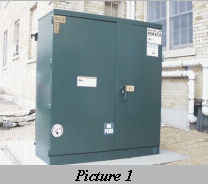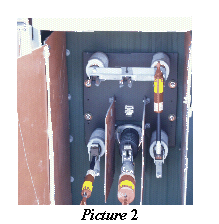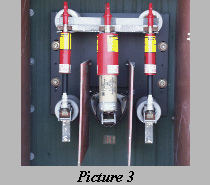The Foreman for an Electrical Construction and Maintenance Company in Texas was Electrocuted after Grabbing Energized Bayonet Fuse in a Live Front Transformer

Texas FACE 99TX202
SUMMARY
On March 30, 1999, a 44 year-old male foreman (the victim) was electrocuted after he grabbed an energized bayonet fuse on a transformer. The victim and co-workers, under contract with the local utility company, were in the process of changing 12 transformers from submersible to pad mounted dead front transformers at an apartment complex.
On the day of the incident the workers were re-energizing the loop after three units had been changed. The three changed units were Nos. 7, 8, and 9 with No. 9 being the last unit to be changed. Units 8 and 10 were used to isolate No. 9 by totally removing the cockable bayonet fuses located on the primary cable sides of each unit. No. 10 had not been changed and was a live front transformer. The fuses energized the primary cable between the transformers. They were returning the units to normal operations by reinstalling the bayonets in Nos. 8 and 10. Unit 8 had been completed and the lineman was working on No. 10. The victim had supervised the change on two transformers and noticed the lineman was having trouble “cocking” the bayonet fuse in No. 10. The lineman was using an 8 foot insulated fiberglass switching stick, or shotgun stick, to install the bayonet fuse. He had hooked the bottom of the bayonet into the lower switch and was trying to cock it or slide down the sleeve in the middle of the tube to reveal the upper metal contact collar to insert into the upper switch. The victim told the lineman to remove the shotgun stick and after removal of the hot stick, the victim placed his left hand on the top edge of the left door of the energized transformer, reached down and grabbed the fuse with his bare hands. This completed the circuit to ground. The flash ignited his clothes and he was electrocuted by 7,200 volts.
Co-workers administered CPR until EMS arrived within 5 minutes after the incident. The victim was transported to a hospital and was pronounced dead within a half hour after the incident.
The Texas FACE investigator concluded that to reduce the likelihood of similar occurrences, employers should:
- Use “live work” visual indicators
- Utilizing detailed diagrams and schematics, train field personnel about the systems and processes involved
- Develop and implement a checklist on standard operating procedures to be used as process steps are completed
- Require use of appropriate personal protective equipment (PPE) for all employees in the presence of potentially hazardous conditions
- Evaluate the effectiveness of safety training programs by conducting regular inspections and observing work procedures
INTRODUCTION
On March 30, 1999, a 44 year-old male crew foreman (the victim) was electrocuted when he grabbed an energized bayonet fuse on a pad-mounted live front transformer. The regional OSHA office notified the Texas FACE program officer of the incident on April 8, 1999. The TX FACE program officer visited the site on April 22, 1999 and interveiewed the employer’s Underground Supervisor. He also obtained and reviewed the OSHA 36, OSHA Inspection Report and Narrative, a newspaper article; Fire/EMS report; and Medical Examiner’s report.
The company had been in business for 20 years, building and maintaining underground and overhead electrical transmission systems on a contract basis. The Texas division was created in 1997. The company employed 100 workers in the Texas division and 22,000 employees nationwide. Twenty employees within the Texas division performed the same duties as the victim.
A written safety program managed by a designated safety director was in place. The program included written safe work procedures specific to the victim’s task. His task on the day of the incident was to observe and correct any activity that was contrary to good job behavior and work procedures. Safety meetings were conducted on a weekly basis in the form of tailgate talks and job site talks were conducted daily. New-hire, task-specific and refresher training was conducted. The victim was responsible for training his crew on safety procedures.
The company conducted pre-employment physicals and drug screening.
The victim was a trained and licensed electrician with 17 years of experience. He had been employed with the company for two years as a crew foreman
This was the first fatality that the employer had experienced.
INVESTIGATION
A crew foreman (the victim) and his crew of 4 linemen under contract with the local electrical utility company were changing submersible transformers to single phase pad-mounted dead front transformers in an apartment complex. Live front transformers have energized parts when the doors are opened. Dead front transformers have no energized parts exposed when the doors are opened The pad-mounted transformers measured 43″ wide, 48″ high, and 48″ deep (see Picture 1). On the day of the incident the crew was working on a loop of 12 transformers and was changing units Nos. 7, 8, and 9 (dead front transformers). The transfer had been completed on two transformers (nos. 7 and 8) and they had just changed No.9 and were in the process of re-energizing the loop of transformers. In order to isolate No. 9 to work on it, the transformer’s links to the primary cable were disconnected to de-energize the sections of underground voltage lines from No. 8 to No. 9 and from No. 9 to No. 10 (live front transformer). Bayonet fuses inside the transformer doors of Nos. 8 and 10 continued the circuit for the primary cable and were removed to isolate power from reaching No. 9.
The crew was returning things back to normal on No. 10 by reinstalling the bayonet fuse between two switches (see Pictures 2 and 3), which would re-energize the primary cable to No. 9. It was written company policy that an 8 foot, insulated, fiberglass shotgun or hot stick was to be used when making energized connections within a pad-mounted transformer. When the victim approached No. 10, he noticed the lineman having trouble “cocking” the bayonet fuse to insert it into the top switch. “Cocking” is the process of grabbing the middle of the bayonet fuse and sliding the sleeve covering down to reveal the metal contact collar at the top. This metal contact collar was then to be hooked into the top switch to complete the connection and fully energize the system. The fuse would be “hot” at this point. The victim told the lineman to remove the hot stick. The victim then walked three feet to the transformer, leaned his left hand on the top edge of the transformer, and with his left forearm touching the left transformer door, grabbed the electrically energized fuse with his unprotected, bare right hand. This completed the electrical path to the ground, and he was electrocuted by 7200 volts. The resulting flash caused his clothing to catch on fire.
Co-workers applied CPR until EMS arrived within five minutes after the incident. EMS administered CPR, employed a defibrillator, and administered medications en route to the hospital. The victim had electrical burns on his head, left eye, and upper right and left arms. He remained unconscious and had no pulse, blood pressure, or respiration. He was transported to a hospital where he was pronounced dead about a half hour after the incident.
CAUSE OF DEATH
The medical examiners concluded that the victim died as the result of electrocution.
RECOMMENDATIONS/DISCUSSION
Recommendation #1: Employers should use visual indicators for “live work”
Discussion: No one will ever know why the victim was not wearing the required personal protective equipment, why he grabbed the fuse, or why he laid his hand on the transformer. He may have confused the transformer numbers and thought it was No. 9, a dead front transformer, being worked on, so nothing would be energized with the door being open. Placing signs, pilot lights and/or voltmeters on top of the transformer as visual indicators of hot work would help to prevent this type of incident. Strobe or flashing lights are relatively inexpensive and can be placed on the transformer and other areas where personnel are working on energized parts or systems. No one should ever be allowed anywhere near live or hot work areas without proper training and proper personal protective equipment. Written procedures similar to lockout/tagout procedures should detail the steps to activate and de-activate the visual signals.
Recommendation #2: Employers should utilize detailed diagrams and schematics, train field personnel about the systems and processes involved.
Discussion: All field personnel should be knowledgeable about the system they are working on or near and understand the process steps necessary to complete their work. Prior to beginning work, drawings of the work process should be discussed and made available to personnel. This procedure should highlight the location, power, design and capabilities for those lines and equipment on which work is about to begin.
Recommendation #3: Employers should develop and implement a checklist on standard operating procedures to be used as process steps are completed.
Discussion: Standard operating procedures should include the use of checklists detailing process steps and requiring sign-off on each step. No one should be allowed to proceed to the next step if there is not a sign-off of the prior task. Checklists should be designed according to the specific job, personnel, and location.
Recommendation #4: Employers should require the use of appropriate personal protective equipment (PPE) for all employees in the presence of potentially hazardous conditions
Discussion: On the day of the incident the victim’s job was to supervise and observe the transformer modifications. Company policy required all employees working in or around or standing in the vicinity of an energized cable and/or equipment to have rubber gloves on or in their possession. The only PPE the victim was wearing was a hard hat and safety glasses. The victim did not use the 8-foot long fiberglass switching stick required by company policy for safely energizing primary cable connections. Why the victim attempted to operate the energized switch without appropriate PPE is not known, especially since he was qualified (as defined by OSHA) to work on electric power transmission. OSHA (CFR1910.269(2)(ii)(D) stipulates that to become qualified on electrical power transformers employees must be trained and competent in: “The proper use of the special precautionary techniques, personal protective equipment, insulating and shielding materials, and insulated tools for working on or near exposed energized parts of electric equipment.”
Protective and insulating materials should always be used when working with energized electric systems or components. This company’s policies explicitly instructed employees as to what PPE was to be used when working on pad mount transformers. For instance, policies required employees to use “an approved switching tool, 20 KVA rated Type 1 Class 2 rubber gloves, hard hat and eye protection, rubber dielectric overshoes, Type 1 Class 2 rubber sleeves…when switches in an energized primary circuit are opened and closed.” Rubber insulated mats can also be used when the environment is conducive for employees to stand on them to increase the protective barriers between employees and electrical energy sources. Use of appropriate PPE by the victim may have eliminated or decreased his exposure to contact with energized electrical components.
Recommendation #5: Employers should evaluate the effectiveness of safety training programs by conducting regular inspections and observing work procedures.
Discussion: A successful training program will help managers establish safe work procedures and will clearly define the consequences of not following these procedures. Safety procedures should be demonstrated and employees should be formally tested on procedure components. However, the ultimate measure of program effectiveness is whether or not employees follow proper procedures and continue to follow them after the training. This can only be determined by field observation of individual worker habits. First line supervisors, such as foremen, are ideally situated to perform this function. Employers should recognize that forepersons may also feel the need to “lend a hand” and will be exposed to the same hazards as a worker. To completely evaluate the training program, regular observations of work habits should be conducted at all levels of the workforce.
The victim observed his crew regularly as required by company policy. Also, the General Foremen made unannounced visits to work sites to observe work procedures and safety rules. A program was in force to discipline noncompliance with the safety rules. The victim did not have any records indicating previous disciplinary action.
REFERENCE
- OSHA (CFR1910.269(2)(ii)(D)
ILLUSTRATIONS

PAD-MOUNTED TRANSFORMER
 |
 |
| De-energized | Energized (Hot) |
BAYONET FUSES INSIDE LIVE FRONT TRANSFORMER
Please use information listed on the Contact Sheet on the NIOSH FACE web site to contact In-house FACE program personnel regarding In-house FACE reports and to gain assistance when State-FACE program personnel cannot be reached.
Back to NIOSH FACE Web
